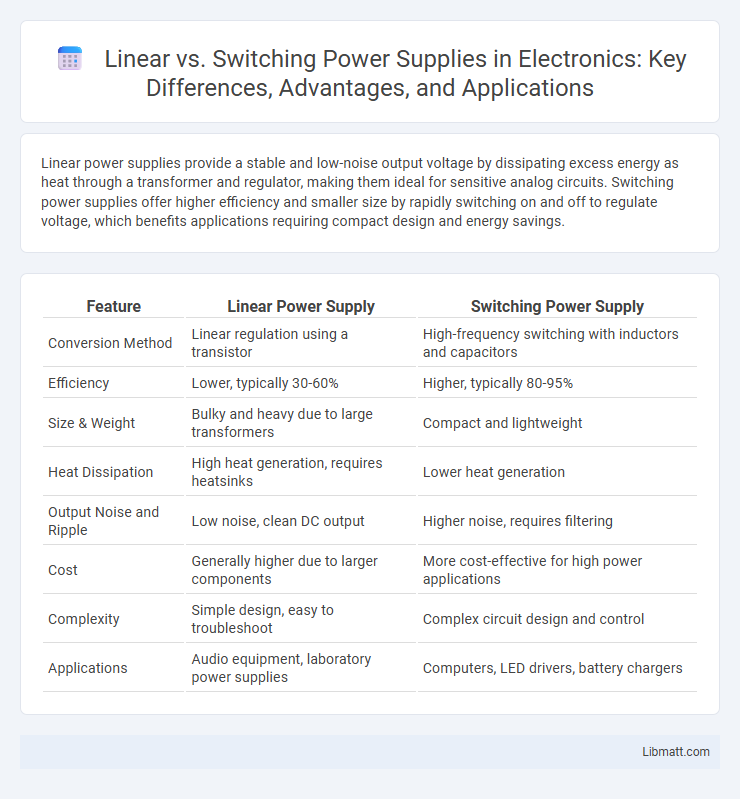Linear power supplies provide a stable and low-noise output voltage by dissipating excess energy as heat through a transformer and regulator, making them ideal for sensitive analog circuits. Switching power supplies offer higher efficiency and smaller size by rapidly switching on and off to regulate voltage, which benefits applications requiring compact design and energy savings.
Table of Comparison
| Feature | Linear Power Supply | Switching Power Supply |
|---|---|---|
| Conversion Method | Linear regulation using a transistor | High-frequency switching with inductors and capacitors |
| Efficiency | Lower, typically 30-60% | Higher, typically 80-95% |
| Size & Weight | Bulky and heavy due to large transformers | Compact and lightweight |
| Heat Dissipation | High heat generation, requires heatsinks | Lower heat generation |
| Output Noise and Ripple | Low noise, clean DC output | Higher noise, requires filtering |
| Cost | Generally higher due to larger components | More cost-effective for high power applications |
| Complexity | Simple design, easy to troubleshoot | Complex circuit design and control |
| Applications | Audio equipment, laboratory power supplies | Computers, LED drivers, battery chargers |
Introduction to Power Supplies
Power supplies convert electrical energy into the appropriate voltage and current needed for electronic devices, with linear and switching power supplies being the two primary types. Linear power supplies regulate voltage using a transformer and linear regulator, offering low noise and simplicity but lower efficiency and larger size. Switching power supplies use high-frequency switching components to achieve higher efficiency and smaller size, making them ideal for modern, compact electronic applications.
What is a Linear Power Supply?
A linear power supply converts AC voltage to a stable DC voltage using a transformer, rectifier, and a series regulator to maintain a constant output. It provides low noise and low ripple, making it ideal for sensitive audio and laboratory equipment. Your choice of a linear power supply ensures reliable, clean power with simple design and minimal electromagnetic interference.
How Does a Switching Power Supply Work?
A switching power supply converts electrical power by rapidly switching its internal transistors on and off to regulate output voltage and current efficiently. It uses high-frequency transformers and inductors to transfer energy with minimal loss, enabling compact size and high efficiency compared to linear power supplies. This method allows switching power supplies to handle a wide input voltage range while maintaining stable output.
Key Differences: Linear vs Switching Power Supply
Linear power supplies regulate voltage by dissipating excess power as heat through linear components, resulting in lower efficiency but simpler design and less electromagnetic interference. Switching power supplies convert voltage using high-frequency switching components, offering higher efficiency, smaller size, and better heat dissipation but generating more electrical noise. Key differences include efficiency rates typically around 50-60% for linear versus 80-90% for switching, form factor size, heat output, and complexity in circuit design.
Efficiency Comparison
Linear power supplies typically offer lower efficiency, often ranging between 20% to 60%, due to energy dissipation as heat in the regulating transistor. Switching power supplies achieve higher efficiency, commonly between 80% to 95%, by rapidly switching components on and off to minimize energy loss. Your choice impacts energy consumption and thermal management, with switching supplies generally preferred for applications demanding power efficiency and compact design.
Noise and Ripple Characteristics
Linear power supplies generate lower noise and minimal ripple due to their simple design with a linear regulator, making them ideal for sensitive audio and RF equipment. Switching power supplies typically produce higher noise and ripple because of high-frequency switching, but advanced filtering and shielding can mitigate these effects for most applications. Your choice should consider the noise tolerance of your device to ensure optimal performance and signal integrity.
Size and Weight Considerations
Linear power supplies are typically larger and heavier due to their bulky transformers and heat sinks required for voltage regulation. Switching power supplies use high-frequency transformers and electronic components, significantly reducing size and weight while maintaining efficiency. Your choice depends on space constraints and portability needs, as switching supplies offer compactness ideal for modern, lightweight devices.
Applications of Linear vs Switching Power Supplies
Linear power supplies are widely used in applications requiring low noise and minimal electromagnetic interference, such as audio equipment, laboratory instruments, and medical devices. Switching power supplies excel in scenarios demanding high efficiency, compact size, and lightweight design, making them ideal for computers, telecommunications, and battery-powered devices. Your choice depends on the specific need for precision versus energy efficiency in the application.
Cost Factors and Economic Impact
Linear power supplies generally have higher operating costs due to energy inefficiency and heat dissipation, resulting in greater electricity expenses over time. Switching power supplies offer cost savings through higher efficiency, smaller size, and lighter weight, reducing material and shipping expenses. The initial investment in switching power supplies may be higher, but long-term economic benefits include lower energy bills and maintenance costs.
Choosing the Right Power Supply for Your Needs
Selecting the right power supply depends on efficiency, noise tolerance, and size requirements. Linear power supplies provide low noise and stable output ideal for sensitive analog circuits but tend to be bulky and less efficient. Switching power supplies offer higher efficiency, compact size, and versatility, making them suitable for digital devices and battery-powered applications.
Linear vs Switching Power Supply Infographic

 libmatt.com
libmatt.com